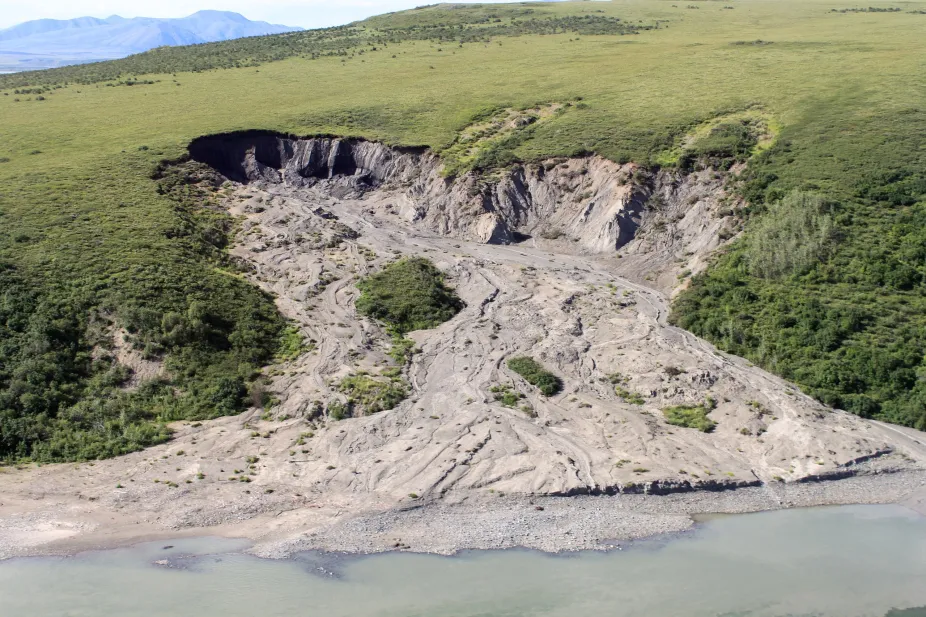The Warming Arctic
In the north polar region, the climate is warming rapidly, much faster than elsewhere in the world. In Alaska, average annual temperatures have increased an average of 0.4°C (0.7°F) per decade since the late 1970s, about twice as fast as the global average. Arctic-wide, in less than half a century, from 1971 to 2019, the average annual temperature rose by 3.1°C (5.8°F).
The warming temperatures are dramatically reshaping the ice, soils, and wildlife in the Arctic. The changes in sea ice cover are already particularly profound, with the summer thickness of sea ice in the Arctic at levels about half of what it was in 1950.
Warmer Arctic temperatures cause melting snow and ice.
Glaciers, including both mountain glaciers and parts of Greenland’s massive ice sheet, are melting rapidly. Sea ice extent and thickness is decreasing in the Arctic Ocean, with climate models projecting the complete disappearance of late-summer sea ice by the middle of the century. Less sea ice will make the Arctic Ocean more accessible to large ships, and researchers are working to predict the impact that future ship traffic will have on Arctic ecosystems.
Warmer temperatures are causing fewer days of snow cover each year in the Arctic. Less snow cover has a compounding effect because it exposes darker ground surfaces, which allows more solar radiation to be absorbed. This, in turn, leads to more snowmelt.

Warmer summer temperatures cause permafrost - frozen ground - to thaw. This can cause slumps in the tundra like this one in Noatak National Preserve, Alaska.
National Park Service
Soils are thawing.
Permafrost soils typically remain frozen year-round, but as the Arctic warms, these soils are thawing. As they thaw, permafrost releases methane, a greenhouse gas, into the atmosphere. The ground becomes increasingly unsteady as permafrost soils thaw, which is causing damage to buildings and roads.
Along the coast, thawing permafrost is causing erosion, like in the picture above, which is a challenge for Arctic coastal communities. Typically, trees and shrubs are unable to grow in the frozen permafrost soils. However, because of the thawing, shrubs and trees are starting to expand further north into the tundra of Alaska and are affecting tundra ecology.
Wildlife is changing.
The species and population sizes of plants and animals are also changing in the Arctic. Some species are moving into new places as the climate changes, disrupting ecosystems. Other species have experienced population booms or declines.
Caribou and reindeer populations, for example, are in flux. Between 1998 and 2018, the overall number of caribou and reindeer in the Arctic declined by 56%. The number of Peary caribou, which are found only in the Canadian Arctic, shrank from 22,000 to only 5,400 between 1987 and 1996. They are listed as endangered by the Canadian government. In 2006, the number had grown to 13,200 caribou. There are two ways that climate change is likely affecting the number of Peary caribou: more severe weather events, which are affected by climate change, make it difficult for the caribou to find food, and melting sea ice restricts their migratory routes making breeding less successful.
Shrinking sea ice is causing changes in wildlife that typically rely on the ice. Polar bear populations are declining because melting sea ice means there are fewer places for them to hunt. Walruses are now found in abnormally large numbers on the shores of Alaska and Russia due to disappearing sea ice which they rely upon to rest, feed, and warm.
Meanwhile, in Alaska, warming temperatures have contributed to drought in coastal forests, and spruce bark beetles are breeding faster than ever in the warmer, drier climate. The oversized beetle population has chewed millions of acres of forest trees since the 1990s, with an additional 900,000 acres impacted between 2016-2018.
© 2019 UCAR with portions adapted from Windows to the Universe (© 2008 NESTA)